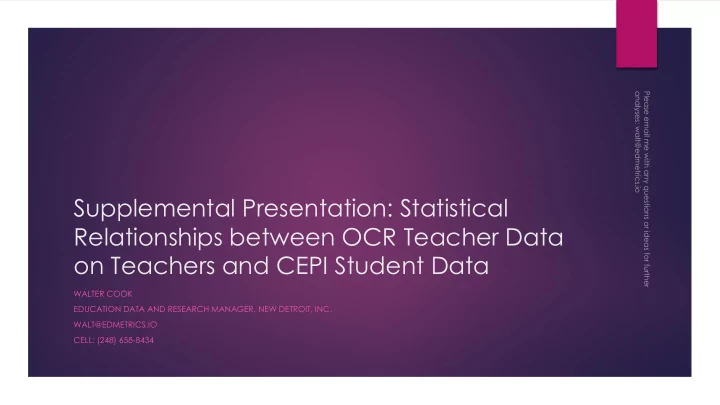

Supplemental Presentation: Statistical Relationships between OCR Teacher Data on Teachers and CEPI Student Data WALTER COOK EDUCATION DATA AND RESEARCH MANAGER, NEW DETROIT, INC. WALT@EDMETRICS.IO CELL: (248) 658-8434
Objectives of This Presentation Note: This is intended as a supplemental Powerpoint to “CFDS Talent Committee: Office of Civil Rights (OCR) Data on Teachers” This supplement will build on the primary Powerpoint in order to: Provide a brief, (relatively) non-technical overview of what a correlation coefficient is and how to interpret it Present some very preliminary correlational analysis between OCR data on teachers and Please email me with any questions or ideas for further analyses: walt@edmetrics.io
Real Quick Statistics Review… CORELATION COEFFICIENT : Measures the relative strength of the linear relationship between two variables (specifically, Pearson’s r) Can take on any value from -1 to +1 -1 indicates a perfectly linear negative relationship 0 indicates that there is no linear relationship +1 indicates a perfectly linear positive relationship That is, the larger the absolute value (i.e., farther from zero), the stronger the relationship This is a very basic, preliminary analyses intended to provoke additional questions to explore with more sophisticated analysis rather than definitively provide answers Often there are relationships between variables that emerge when you “control” for other factors, but looking at the relationships between pairs of variables can be a helpful starting point Please email me with any questions or ideas for further analyses: walt@edmetrics.io
A Picture Is Worth… Please email me with any questions or ideas for further analyses: walt@edmetrics.io
Legend to Color Coding on Following Slides Please email me with any questions or ideas for further analyses: walt@edmetrics.io
OCR Teacher Covariates Compared to Building-Level Student Demographics (All) Please email me with any questions or ideas for further analyses: walt@edmetrics.io
Some Surprising Findings from the Preliminary Correlational Analysis (1 of 2) Across all schools, there is not a statistical relationship between Teacher Chronic Absenteeism and Student Chronic Absenteeism For both teachers and students, “chronic absenteeism” is defined as missing 10 or more school days Somewhat surprising that this doesn’t appear to be a modeled behavior There is a positive relationship between Average Teacher Salary and Student Chronic Absenteeism Could be a good thing if it indicates that more experienced teachers are working with more disadvantaged populations Very surprising because Charter students have the highest rate of Chronic Absenteeism, yet Charter teachers have considerably lower average salaries Please email me with any questions or ideas for further analyses: walt@edmetrics.io
Some Surprising Findings from the Preliminary Correlational Analysis (2 of 2) There is a positive relationship between Average Teacher Salary and Percentage of Black Students, while Negative between Average Teacher Salary and Percentage of White Students Likely an artifact of a larger proportion of white students attending Charters, which average lower teacher salaries than DPS Please email me with any questions or ideas for further analyses: walt@edmetrics.io
Recommend
More recommend